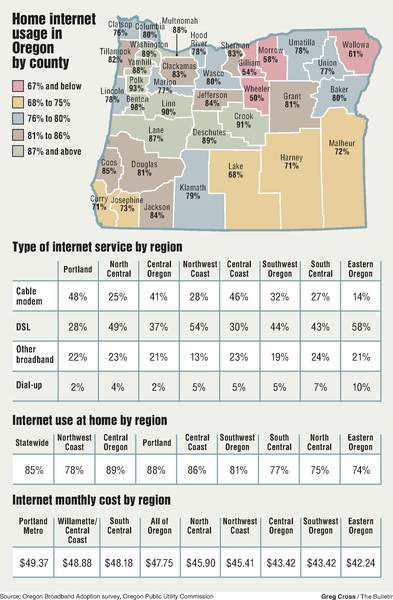Oregonians get broadband
Published 5:00 am Monday, October 1, 2012

- Oregonians get broadband
Oregon’s adoption of high-speed Internet service exceeds national levels, and Central Oregon is leading the way with the highest level of access and use of broadband at home in the state, according to a report released last month by the Oregon Public Utility Commission.
For businesses in Central Oregon, broadband is not a luxury but a necessity. That might help explain the region’s usage level, said Roger Lee, executive director of Economic Development for Central Oregon.
“Here, we realize we are a smaller market, and we need that outside connection,” Lee said. “In order to operate some of our businesses that aren’t place bound — required to be in large metro areas — we need the ability to transport large amounts of data fast to our customers.”
Despite the high rates of broadband adoption in Central Oregon, the Portland area and other regions, more work is needed to bridge the digital divide throughout the state.
To identify the challenges that might prevent state residents from accessing and using high-speed Internet services in Oregon, the PUC commissioned a survey in 2010 using funds from the American Recovery and Reinvestment Act. On Sept. 10, the PUC released the results in the Oregon Broadband Adoption report.
The survey examined how many Oregonians have computers and use broadband Internet services, the cost of the service and its availability.
“Oregonians have adopted it here so much quicker than the rest of the nation has,” said Shelley Jones, senior policy analyst for the PUC.
Oregon has an 82 percent adoption rate, compared to 68 percent nationwide, the report said.
Jones said the difference could be attributed to higher rates of Internet use by low-income and older residents in Oregon, compared to the nation.
For those Oregonians not using broadband, the survey found that cost, followed by being comfortable with the Internet were the primary factors,not availability. That finding surprised the commission, Jones said.
“There are more people not adopting broadband because it cost too much, or because they have little perceived value for it, than there are people not adopting it because it’s not available,” she said.
Those living in Central Oregon and Portland, the regions with the highest adoption rates, were the most likely to feel that it is important to have high-speed Internet access at home, according to the report.
Based on separate data from the Federal Communications Commission, about 99.5 percent of Deschutes County had access to broadband in 2011. In Crook County, about 91 percent had access and about 89 percent in Jefferson County.
Lee, of EDCO, said those in the High Desert have multiple options for service, and he agreed that cost, not availability, is more of an issue for Central Oregonians who are not using broadband.
“In other parts of the world, it is really cheap,” he said, “as low as $10 a month.”
On average, broadband costs users about $43 a month in Central Oregon, according to the survey. The figure is nearly $6 a month less than the Portland Metro region, which had the highest rate.
In addition to quantifying the number of broadband adopters, Jones said the survey also aimed to identify what they used it for, in hopes of aiding the Oregon Broadband Advisory Council.
However, a lot has changed in the two years since the survey was conducted, with much of it fueled by federal stimulus funding.
In Crook County, a public computer lab openedin August 2011 as part of the Central Oregon Community College Crook County Open Campus. Funded, in part, by nearly $4 million through the Broadband Technology Opportunity Program and by COCC, the project contains multiple classrooms with the latest technology, teaching resources and the computer lab, according to the website of Oregon Open Campus, which is run by Oregon Statue University.
BendBroadband, the Bend-based cable TV, Internet and telephone provider, expects to have about 90 percent of its fiber-optic highway completed in the third quarter, according to its most recent report filed with the National Telecommunications and Information Administration. The project, funded by $4.4 million from the American Recovery and Reinvestment Act and by BendBroadband, will extend high-speed Internet service to underserved areas of La Pine, Madras, Prineville and Sunriver.
In the spring, Warm Springs Telecommunications Co. began providing the community expanded and improved Internet service, paid for with $5.4 million from the Recovery Act.
Despite the new developments since the survey, Bob Valdez, public affairs specialist for the PUC, said the report will still be helpful.
“I think it will still have a lot of value for cities and counties that look at what the existing availabilities are, even though there is a lag in the actual data,” he said.
He said the information has been shared with legislators to give them a snapshot of Oregon’s broadband availability and how it compares nationally. It will also provide lawmakers information if they are considering related legislation, he said.
“The availability of broadband is becoming more of a crucial part of life for information, for people who have businesses … and for people to be able to access services they are entitled to from the state, counties and or cities,” he said.






